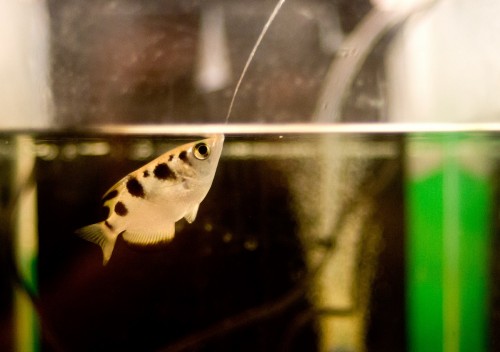How similar is the way in which humans and animals allocate their visual attention in order to deal with different tasks?

Researchers from Ben-Gurion University who studied the phenomenon shed new light on this new and interesting phenomenon. In a new study, published at the beginning of April in the "Nature Communication" newspaper, the group of researchers, Prof. Avishai Hanik, Dr. Shai Gabbai and Tali Leibovitch, a doctoral student from the Department of Psychology, and Prof. Ronan Segev and Dr. Avi Ben-Simon from the Department of Life Sciences, were assisted In the archer fish in order to answer this question.
"The rainbow fish was chosen to be used as a model animal thanks to its unique way of hunting: intercepting insects that are in the vegetation above the surface of the water by spraying a jet of water from its mouth. The rainbow fish is also able to learn to distinguish between artificial stimuli presented to it on the back of a computer screen as part of an experiment, and to respond to them by splashing water." Prof. Ronan Segev explains. The rainbow fish, despite the lack of a developed cerebral cortex, displayed attentional patterns similar to those of humans.
The results of this work, which are currently unique to rainbow trout, demonstrate important aspects in the study of attention. This study suggests that mechanisms of basic attention processes developed relatively early in evolution and made it possible to function in the environment with the help of a very primitive system. This work was supported by the National Science Foundation to Professor Ronan Segev, and a grant from the European Science Foundation
(European Research Council - ERC), within the seventh program for Professor Avishai Hanik.
It should be noted that attention, a critical component of information processing processes in humans, is the ability to concentrate on a specific aspect of the environment or on a specific task. Because humans use the sense of sight intensively, visual attention processes are widely studied by the scientific community. A system that directs our attention from subject to subject allows us to concentrate brain resources in order to achieve a certain goal, for example to concentrate on what is written on the class board during a lesson.
"Sometimes, our distraction is unintentional. For example, when a door slams loudly during a classroom lesson, our attention is automatically, or reflexively, diverted to the source of the noise. This distraction is not a simple process; Response to the areas to which we directed the attention is very fast at first and then it is slower. In the past, researchers have suggested that this late slowness is intended to optimize visual search. That is, to prevent us from returning too quickly to the areas that we have paid attention to recently and thereby creating a preference for areas in the space that we have not paid attention to recently. This ability is important both for us and for living. For example there is no point in looking for the keys we lost (for humans) or prey (both humans and animals) in the area we searched last. This phenomenon is called "return delay". What enables the delayed return phenomenon? Previous studies on the subject suggested that the phenomenon originates in structures in the midbrain. Other studies suggest that structures in the cerebral cortex are essential for the inhibition of repetition", explains Prof. Avishai Hanik.
Although the phenomenon of "delayed return" is an important aspect of visual attention in animals in general, the vast majority of studies have been conducted in humans. The study of the phenomenon in animals is rare. Therefore, as mentioned, the research focused on examining this important and interesting question - how similar is the way in which humans and animals allocate their visual attention in order to deal with different tasks?
